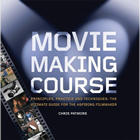BOOK REVIEW:
So you want to be a filmmaker?
But
perhaps you don’t have the time or the money to take
up a movie making courses? Or perhaps you are in the Robert
Rodriguez’s camp who scorn at the idea of paying thousands
to learn movie making in a classroom environment? Whatever
the case is, if you are a novice with little idea about the
process of filmmaking and have a strong interest in making
a movie (or ideally short film for starters), Chris Patmore’s
Movie Making Course book is a good place to start that journey.
Movie
Making Course covers a wide spectrum of the movie making process
without overwhelming the readers with details or words, an
excellent way of introducing newbies to the world of filmmaking,
especially to those who don’t have the time to crawl
through thick textbooks of similar genre.
This
book is break into three main sections covering the pre production,
the shoot and the postproduction. It’s also cover on
the equipments, the type of projects that could be undertaken
and how to get your film seen, but in this review, let’s
focus on what the three main sections have to offer.
In
each of the three main sections, each section is divided systematically
into specific task that could be performing during movie making
process. In the pre production, it touches on the formation
of the story and the pre production essential such as budget,
crew, casting, location and etc.
One
of the interesting bits of the pre production aspect in this
book would be on how to test an actor’s skills and ability
to get into character. For a beginner who is casting actors
for his or her film, this segment gave 4 methods to test what
the actor is capable of. This methods help in making the most
of an audition and present a certain sense of professionalism
even though it’s might be the first time for the person
in charge.
In the shoot, this book covers the different types of lighting,
the basic of shooting a film, how to composite a shoot and
how to move the camera. It also covers the important points
of sound and directing. One rather unexpected task that was
presented here would be the catering aspect.
For
those who never been involved in an actual shoot might find
it surprising that catering for the crew is an important factor
in a film production that shouldn’t be taken lightly
or forgotten. It might seem unimportant but a hungry or staving
crew will most likely be unable to produce a fine piece of
work as their mind are focus somewhere else.
This
book even present the “How not to feed the crew”,
a sample menu for location with no power supply and even an
easy to make pasta recipe to give readers a start in dealing
this aspect of film production.
Last
but not least, the postproduction. Since the most affordable
tools for post production work on the market nowadays is in
digital format, this section of the book focus on the digital
aspect of post production work for editing, music and titles
/ credits.
It
also touches on special effects, as it’s no longer an
exclusive element of filmmaking to major film production team.
Nowadays special effects could be achieved on a standard desktop
computer and this book throws in a few suggestions on the
affordable software to spice up the film by adding computer-generated
images or removing certain images.
There
are plenty more in this book but you simply have to pick it
up to learn the tricks of the trade.
CHOICE XCERPT:
“This book has been designed to be as concise as possible
because one of the greatest enemies of the novice filmmaker
is procrastination. “I’ll make my film when I’ve
read this book or that book”; “I can’t do
it until I have enough money for a crew and equipment”.
The excuses go on and on. This short book is filled with the
information you need to start making a movie with almost no
money, so you can forget about them.”
VERDICT:
The Choice Xcerpt says it all.
It’s
targeted at all the wannabes with adequate content to keep
one’s interest for filmmaking going. Besides serving
as a jumping board, some of the content featured in this book
will served as a good and fast reference for those who had
gain some experience. It’s does not cover movie making
topics extensively but interested parties should have a jolly
good time going through this book and still gain some knowledge
on the craft of movie making.
XTRAS:
If this book wets your appetite for more and you can’t
wait to get more information, there are links to relevant
websites in selected topics. A selected few websites on the
filming technology and resources are listed at the back of
Further Reading.
Further
Reading also cover on which selected books you could get your
hands on to learn in depth on the aspect on story telling,
practical aspect on film making and getting inspiration to
make that film that one might be forever thinking of doing.
Last
but not least, the Glossary section. The Glossary section
covers all the important terms that this book is concern with
brief explanation on the specialized terms. It will be particularly
helpful for novice to differentiate Foley to Dolly or what
does ADR or NLE stands for.
   
Review
by Richard Lim Jr
|

